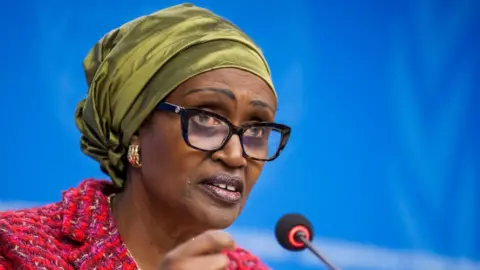BBC Geneva correspondent
 AFP
AFPUS funding cuts will result in an extra 2,000 new HIV infections every day and over six million additional deaths over the following 4 years, the UNAids chief has warned.
It will mark a stark reversal within the international combat towards HIV, which has seen the variety of deaths from the illness lower from greater than two million in 2004 to 600,000 in 2023, the latest 12 months for which figures can be found.
UNAids Government Director Winnie Byanyima mentioned the US authorities’s choice to pause international assist – which included funding for HIV programmes – was already having devastating penalties.
She known as on the US to reverse the cuts instantly, warning girls and ladies have been being hit notably onerous.
US President Donald Trump introduced the pause on international assist, for an preliminary 90 days, on his first day in workplace in January as a part of a evaluation into authorities spending. The vast majority of the US Company for Worldwide Growth’s (USAID) programmes have since been terminated.
Many US-financed HIV therapy and prevention programmes obtained cease work orders, resulting in the closure of mom and child clinics in Africa, and extreme shortages of life saving anti-retroviral (ARV) medicines.
Ms Byanyima mentioned she feared a return to the Nineties, when HIV medicine was scarcely obtainable in poorer nations, and infections and deaths soared.
The US has for years been the one greatest funder of HIV therapy and prevention, and Ms Byanima thanked Washington for its generosity and humanity.
She added it was “affordable” for the US “to need to cut back its funding – over time”, however mentioned the “sudden withdrawal of lifesaving assist [was] having a devastating impression”.
There was no signal that Washington is listening to appeals to alter course.
Conventional assist donors in Europe additionally plan funding cuts, and UNAids – the joint UN company which combats HIV – has had no indication that different nations may step in to fill the hole left by the US.
Talking in Geneva on Monday, Ms Byanyima described the case of Juliana, a younger lady in Kenya dwelling with HIV. She labored for a US-funded programme that supported new moms to entry therapy to make sure their infants didn’t develop the illness.
With the programme suspended, Ms Byanyima mentioned Juliana was not solely out of labor however, as a result of she was nonetheless breastfeeding her youngest baby, she additionally feared shedding the therapy she wanted.
Beforehand, the World Well being Group (WHO) mentioned eight nations – Nigeria, Kenya, Lesotho, South Sudan, Burkina Faso, Mali, Haiti and Ukraine – may quickly run out of HIV medicine after the US funding pause.
WHO chief Tedros Adhanom Ghebreyesus warned that disruption to HIV programmes “may undo 20 years of progress”.
In February, South Africa’s main Aids foyer group, the Therapy Motion Marketing campaign (TAC), warned the nation may see a return to when HIV sufferers struggled to entry crucial companies for his or her therapy.
“We won’t afford to die, we will not afford to return to these years the place we have been struggling with entry to companies, particularly for folks dwelling with HIV therapy,” mentioned TAC chair Sibongile Tshabalala.
Ms Byanyima additionally proposed a deal to the Trump administration, providing a possibility to market a brand new US-developed ARV to thousands and thousands of individuals.
Lenacapavir, made by US firm Gilead, is given by injection each six months, with UNAids believing 10 million folks may benefit from it.
The income and jobs ensuing from such a deal can be vastly useful to the US, Ms Byanyima added.
UNAids is certainly one of various UN companies dealing with funding cuts.
The UN Refugee Company has steered it might should lose 6,000 jobs, whereas Unicef has warned that progress to scale back baby mortality is threatened, and the World Meals Programme has needed to minimize rations in famine threatened areas.




